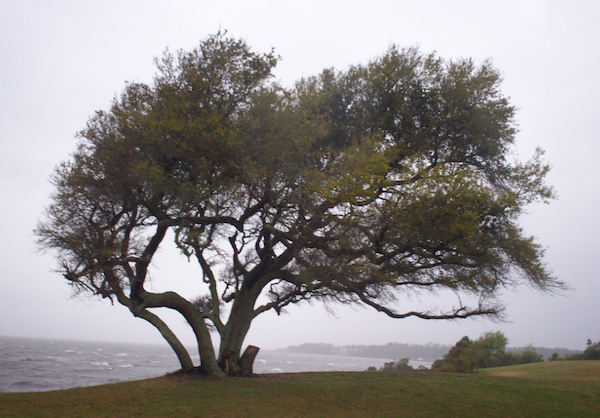The Holy Spirit is a little like the sun. We can’t look directly at it, at least not without hurting our eyes. There’s yet a further complication with seeing the Holy Spirit directly. Dorothy Sayers says, “We cannot really look at the movement of the Spirit, just because It is the Power by which we do the looking.”
Given these limitations, how do we see the Holy Spirit? By the Spirit’s effects. Jesus says to Nicodemus, “The wind blows wherever it pleases. You hear its sound, but you cannot tell where it comes from or where it is going. So it is with everyone born of the Spirit.”
As with the wind, so with the Spirit. The wind moves trees. The Spirit moves people.
One such Spirit-moved man is St. Luke. He’s a very special Spirit-moved man. He, moved by the Spirit, comes to life in Christ and ministers alongside St. Paul. Demonstrating the effects of Holy Spirit St. Luke writes Luke-Acts. By the Spirit he chronicles, praises, and gospels the gospel. What a fitting surprise of providence: a Gentile, inspired by the Holy Spirit of Israel’s prophets, tells the story of the fulfillment of Israel’s story. And he tells it as a member of Abraham’s family of faith.
As with the wind, so with the Spirit. The wind moves trees. The Spirit moves people.
Brittle tress moved by the wind often break. Supple trees moved by the wind dance and shout their leafy halleluiahs. So with people. The brittle, stiff-necked, and resistant can be broken by the strong wind of the Spirit. The pliant respond in varied, trusting, and obedient constancy: patient endurance, to use a New Testament phrase. The effect of the Spirit becomes the worshipful reigning of the royal priesthood.
As with the wind, so with the Spirit. The wind moves trees. The Spirit moves people and makes them Church.
Growing up Southern Baptist, I didn’t know what liturgy was. We had a liturgy of sorts, a general order of service that was repeated weekly: a call to worship preceded by the choir entrance and the entrance of the pastors. They even sat in the same seats every week. It was high church Baptist. And at the end of the service there was one, formal liturgical element.
To conclude each service we spoke what we called the affirmation of faith. The minister of music eventually put it to music. After that we sang it. Saying it and singing it Sunday by Sunday I learned to mean it. I learned to count on it without even thinking about it. It forms part of my vision for what it means to be caught up in Church.
Because you belong to Christ, you are akin to me.
One in the bonds unbreakable, wrought for eternity.
Spirit with spirit joined, who can the ties undo?
Binding the Christ in my heart with the Christ in you.
As a young boy, I never knew what “akin” meant. And “wrought” seemed a heavy, mysterious word. I now know what those words mean. But more is needed than lexical awareness. They speak of a life. A life united with Christ and in Christ. A life animated and moved by the Holy Spirit of God.
As with the wind, so with the Spirit. The wind moves trees. The Spirit moves people and makes them Church.
If the Spirit is moving, making Church out of me and others, then we are an effect and not a cause. An effect does not control its cause. And in our case, the case of the Spirit making people Church, the effect may be one way we can see what can’t be seen directly.
“Just as God the Father is revealed ‘through the things that are made,’ i.e. through the creation, so God the Holy Spirit is revealed through the Church, i.e. through the new creation” (J.G. Davies, TheSpirit, The Church, and The Sacraments, 2).
Of this great mystery there is no end of telling. It will take eternity to sing the praises of him who called us “out of darkness into his marvelous light.”
Yet that eternity of praise begins now as we say and live, “Because you belong to Christ, you are akin to me.”




Missio Alliance Comment Policy
The Missio Alliance Writing Collectives exist as a ministry of writing to resource theological practitioners for mission. From our Leading Voices to our regular Writing Team and those invited to publish with us as Community Voices, we are creating a space for thoughtful engagement of critical issues and questions facing the North American Church in God’s mission. This sort of thoughtful engagement is something that we seek to engender not only in our publishing, but in conversations that unfold as a result in the comment section of our articles.
Unfortunately, because of the relational distance introduced by online communication, “thoughtful engagement” and “comment sections” seldom go hand in hand. At the same time, censorship of comments by those who disagree with points made by authors, whose anger or limited perspective taints their words, or who simply feel the need to express their own opinion on a topic without any meaningful engagement with the article or comment in question can mask an important window into the true state of Christian discourse. As such, Missio Alliance sets forth the following suggestions for those who wish to engage in conversation around our writing:
1. Seek to understand the author’s intent.
If you disagree with something the an author said, consider framing your response as, “I hear you as saying _________. Am I understanding you correctly? If so, here’s why I disagree. _____________.
2. Seek to make your own voice heard.
We deeply desire and value the voice and perspective of our readers. However you may react to an article we publish or a fellow commenter, we encourage you to set forth that reaction is the most constructive way possible. Use your voice and perspective to move conversation forward rather than shut it down.
3. Share your story.
One of our favorite tenants is that “an enemy is someone whose story we haven’t heard.” Very often disagreements and rants are the result of people talking past rather than to one another. Everyone’s perspective is intimately bound up with their own stories – their contexts and experiences. We encourage you to couch your comments in whatever aspect of your own story might help others understand where you are coming from.
In view of those suggestions for shaping conversation on our site and in an effort to curate a hospitable space of open conversation, Missio Alliance may delete comments and/or ban users who show no regard for constructive engagement, especially those whose comments are easily construed as trolling, threatening, or abusive.